|
Warm
up
RML's
raceday began with the official warm-up at nine
o'clock on Saturday morning, and everything went
exactly to plan. The MG wasn't the first out,
but by five after the hour Tommy was heading out
of the pitlane to complete a single installation
lap., The team simulated a driver change when
he arrived back in the pitlane, with Mike quickly
strapped into the car and sent out again. As Tommy
had predicted the day before, Mike was then allowed
the remainder of the forty-five minute session
to improve his familiarity with the track, and
ensure that those minor adjustments made to the
car since Thursday's qualifying had achieved their
objectives.
The
session was still in progress when Mike came back
down the pitlane to finish off his allocation
of six laps. Once again, the team carried out
a full pitstop simulation, with Warren Hughes
helping Mike out of the MG before jumping in.
"It was a useful exercise," said Warren,
"but there's wasn't a lot to be gained by
my doing an out-lap, so we called it a day!"
With
the warm-up satisfactorily completed - "it
all went fine," was Phil Barker's succinct
assessment - the drivers spent time considering
some of the minor problems they might possibly
encounter during the course of the race, and how
they might, perhaps, fix them at the trackside.
Uppermost amongst the most basic skills is the
ability to remove the entire rear bodywork single-handed.
It's a vast section of carbon fibre, and while
not heavy, it's cumbersome. "I had to remove
the back of the car on my own in 2002, when we
had the gearbox failure in the 257," admitted
Warren Hughes. "At least I've got some idea
at how to do it!"
Back to top
Saturday
Morning
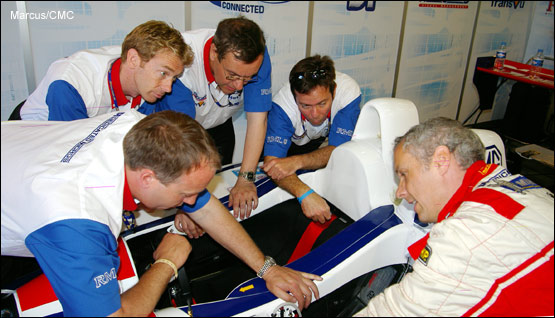
What
is more of a concern for Warren, and the other
drivers, is the electronic and technical complexity
of the car. If the average family saloon now looks
complicated when you lift the bonnet, it's as
nothing compared to the innards of an EX264. "It's
those intricate things on the engine and the electronics
that are more of a challenge. If it's at night,
for real, that could be so much worse. At least
this [talk-through] gives us a chance, although,
hopefully, we won't need any of them." They
were shown how to use a small metal "chock"
to hold the throttle open if the cable breaks.
In conjunction with the pitlane limiter switch,
this would allow them to drive back to the pits.
There was also a special system to overcome a
failed driveshaft, and an "limp-home loop"
that might help in the case of an ECU failure.
Topping it all was what one of the mechanics called
a "handbag toolkit", which contains
some bare essentials, including tape, tie-wraps,
wire and a small selection of tools.
Tommy
Erdos had been confirmed as starting driver on
Friday, and he was looking quite relaxed. "We're
feeling quite optimistic," he admitted. "The
car has always been so reliable in the past, and
we do have backup systems in case we need them.
The team is so well prepared - in fact, better
than I ever known before."
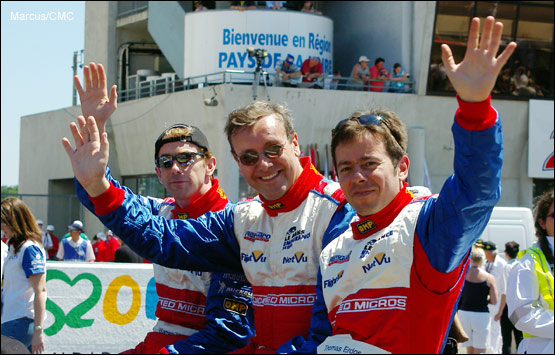
While
the Legends race was entertaining the crowds,
the team busied themselves with final preparations
and an early lunch. Then, with the MG looking
splendid in the bright sunshine, the car was among
the first to be pushed out onto the track in the
traditional herringbone formation. No longer actually
used for the race start, when drivers of old used
to run across the track to their cars, it is still
retained for the final hour or more before the
cars take up their grid positions. It's an occasion
traditionally accompanied by noise, colour, bikini-clad
Hawaiian Tropic girls and irrepressible Gallic
flair. While Bruno Vandestick whipped the crowd
into a frenzy, the drivers were introduced car-by-car,
this year perched on the rear scuttle of Audi
A4 cabriolets. This was followed by the presentation
of the driver's national flags, and then their
anthems - about eighteen this year. Finally, with
forty minutes still to go before the scheduled
four o'clock start, the grid was cleared and the
cars moved off one at a time to begin a parade
lap of the track.
Back to top
The
Grid
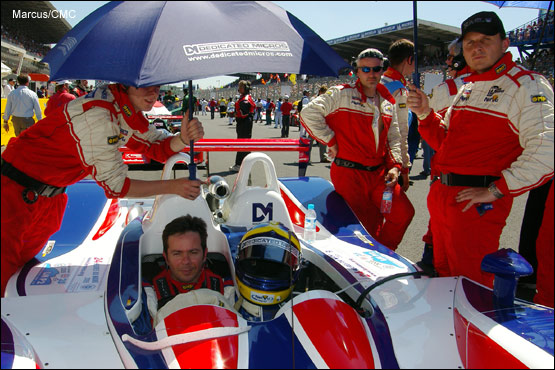
It's
a long drawn-out process, yet the time still seems
to pass quickly, at least for the spectators.
Perhaps less so for the drivers. Beneath a blazing
sun and without even the slightest breeze, it
was an hour or more of torture for the drivers.
The team did their best to shade Tommy beneath
umbrellas, but it was evident even the experienced
drivers on the grid were starting to feel the
heat. Despite the impending start, and the build-up
of adrenalin in the system, it must have been
a great relief when the grid was cleared and the
pace car started the rise up the slope towards
the Dunlop Chicane. There was a brief pause, and
then a staggering noise erupted from the massed
ranks of machinery as the entire field started
off in pursuit.
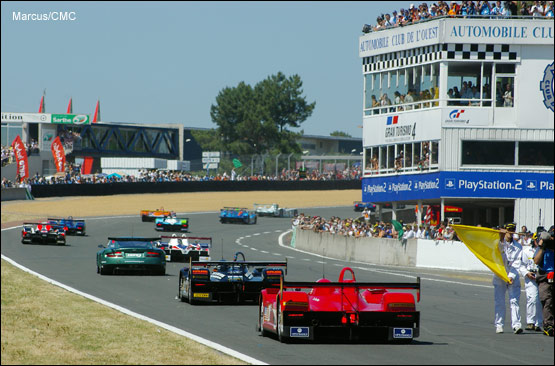
The
Start
This
lap always seems to last an eternity, especially
for those who can't follow the cars' progress
on one of the massive TV screens, and then the
first headlights are seen rounding the end of
the final Porsche Curve, and entering the Ford
Chicane. Slowing to a crawl, the leading Pescarolos,
headed by Boullion in the pole-setting #16, allowed
the pace car to pull clear, looking for space
to control the start. With a bellow of noise,
he gunned it across the line, drawing the forty-seven
other starters after him.
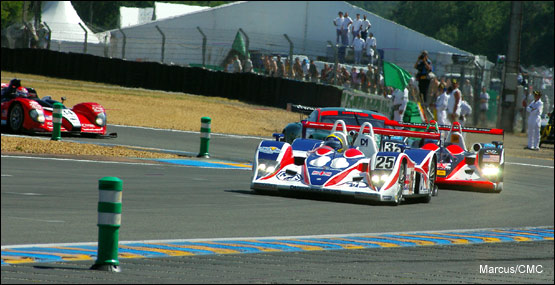
Tommy,
starting from the eighth row, found himself with
more space than he wanted. The #8 Rollcentre Dallara
Nissan would not take the start, so the slot ahead
of the RML MG was vacant. Coming through the Ford
complex he found himself ahead of Sam Hancock
in the Intersport Lola, and emerged onto the pit
straight leading the #32 car. "I don't know
what he thought he was doing! He dropped so far
back that I assumed he had a problem. I backed
right off as soon as we cleared the last corner,
and that allowed Sam to cross the line first,
but it also allowed the Aston through. I suppose
it was all academic really."
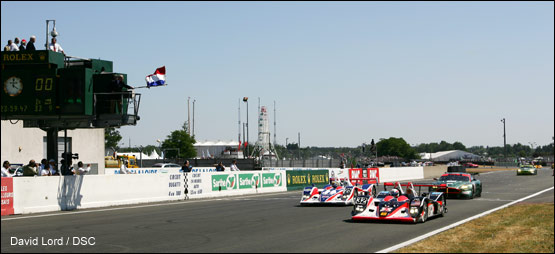
Unfortunately,
all the momentum he'd generated coming through
the corner had been lost, and not only would there
now be no chance of catching Hancock up the straight,
he'd also lost ground for the rest of the lap.
The three LMP2 leaders: André in the #37
Berlmondo Courage, Hancock in the Intersport Lola,
and then Tommy in the RML MG starting, would cross
the line at the end of the first lap almost nose-to-tail.
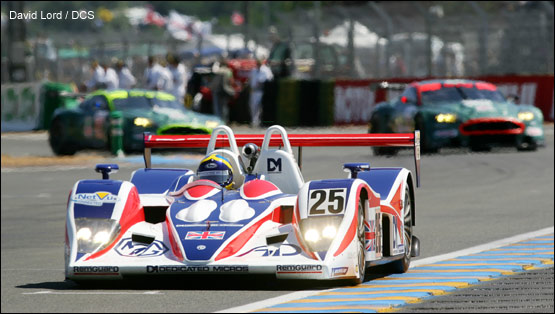
It
was as close as it was ever going to get. At the
end of the next lap, Tommy was straight down the
pitlane. It would be the first of several visits.
The first two calls would be to address an overheating
MG-Judd V8, most probably as a result of an airlock
in the system. "The engine started to overheat
almost immediately, for no obvious reason. It's
never been a problem before, yet the temperature
was up to 125, when the optimum is 85. I had to
come in - it would have ruined the engine if not."
So, while Sam Hancock was taking the lead in LMP2
and struggling to enforce his superiority over
the first of the Aston Martins, the RML mechanics
were purging the MG's cooling system.
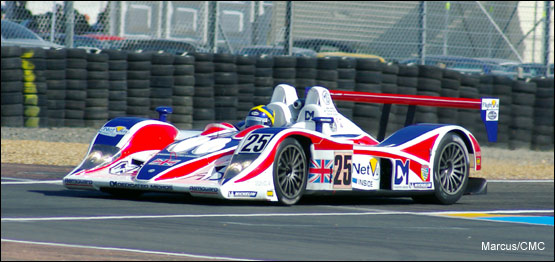
With
eighteen minutes of the race gone, the leading
LMP1 runners were already lapping the last-placed
Cirtek Ferrari 360 #92 and a Panoz Elan had taken
the lead in GT2. Thomas Erdos, meanwhile, was
coming back down the pitlane again, this time
with a gear selection problem. "The compressor
on the downshift had failed, so Tommy could up-shift,
but once in fifth he couldn't come down again,"
came the explanation. That being the case, this
was an occasion when the remedy could not be effected
in the pitlane, so the car was wheeled backwards
into the garage. It would stay there for almost
a quarter hour until the problem could be fixed.
"We changed the actuator and it's looking
fine again now," confirmed Mike Newton.
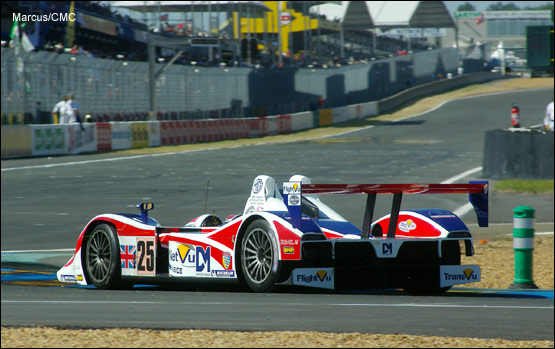
At
four thirty-five the Brazilian was back out on
track, but not for long. This was a single check-up
lap, and it would be nearly five o'clock before
the RML MG would actually resume racing. Tommy's
return to the track was almost overlooked by the
distraction of seeing the #8 Rollcentre Dallara
emerging for the first time, very, very slowly.
Failure to start the race within the first hour
would have lead to instant disqualification, so
the car was making a painfully slow lap of the
circuit before returning to the garage for further
repairs. It would eventually start racing properly,
but not for another half an hour.
Back to top
Hours
Two and Three
By
that time Thomas Erdos was in full flow. In fact,
it would be just ten minutes short of a full hour
before the RML MG would come burbling back down
the pitlane - this time for a scheduled pitstop.
Tommy would stay in the car, take on fuel, and
head back out again. It must have been a rejuvenating
experience. Just as the race entered its third
hour the MG clocked its best lap yet, and 3:52.550
was also one of the quickest set by any car in
LMP2 at that stage of the race. It wouldn't make
a lot of difference to the race order - the fast-moving
MG would still be last - but the prospects suddenly
looked so much more favourable. Things were moving
in the right direction at last.
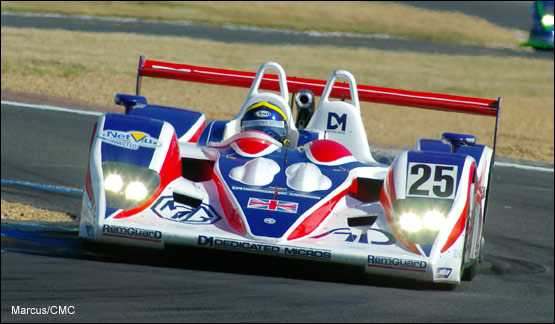
Tommy
was regularly setting times in the sub-fifty five
mark, and hit a landmark ten minutes later by
moving up into 47th position. "The engine
was still running hot," he said. "The
car felt slow down the straights, so I had to
make up for that through the straights and under
braking." The demise of the #39 Chamberlain-Synergy
Lola offered another position, and then shortly
afterwards Erdos set the fastest LMP2 lap of the
race so far, posting 3:50.313. The RML MG was
now lying in 44th place overall, and it wouldn't
be long before the fast-moving Erdos would add
another scalp; that of the ailing Peninsula Racing
TVR. After a discouraging first hour, prospects
for the RML entry were starting to look distinctly
more rosy, especially when Erdos then clocked
the first sub-fifty LMP2 lap. 3:49.723 was nearly
five seconds faster than the next best in LMP2
at the time, a 3:54.088 from #37 Belmondo Courage.
This
brought Tommy's lengthy and turbulent opening
stint to a close. At 6:40 he headed down the pitlane
to hand on to Mike Newton. While the two drivers
exchanged seats, the car was refuelled. That completed,
a shrill blast on the whistle then sent the tyre-fitters
into a blur of frantic action, and within a few
seconds, Mike was disappearing up the hill to
start his first lap of the 2005 Le Mans 24 Hours.
Back to top
Hour
Four
He'd
taken over the car in 40th position, and that's
where he stayed, thanks initially to the deployment
of the safety car. The exact cause wasn't clear,
although the #20 Pilbeam hit a problem about this
time and was stranded on the track. As the hour-hand
clicked over to seven, Mike passed the stricken
car, and thereby moved into 39th place. It was
all steady progress, albeit frustratingly slow.
Having lost more than forty minutes in the garage
so early in the race, it was going to take some
time before anyone felt that the tables might
be turning.
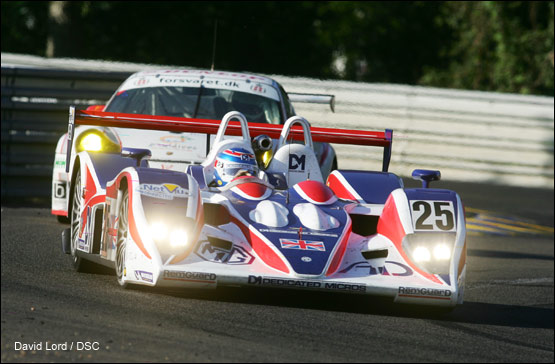
The
safety car release was very strangely handled.
On a circuit that's over thirteen kilometers in
length, one safety car is simply not enough, which
poses the challenge of how two, or sometimes three,
are withdrawn simultaneously. On this occasion
no attempt was made whatsoever, and while racing
resumed across the startline, a second group along
the Mulsanne were still being held behind flashing
orange lights. This set up the situation of one
group at racing speed bearing down on the tail
end of a group still travelling at safety-car
pace. Thankfully reason was restored before disaster
struck, but then it did anyway. Pirro, at the
time leading the race in the #2 Champion Audi
R8, went straight on at the Arnage corner, caught
out after the restart by a punctured tyre. He
was able to pit, and the car was repaired, but
when McNish resumed racing, it was no longer from
the lead.
Hour
Five
Mike
Newton was settling down to a steady rhythm, posting
a succession of laps that hovered most respectably
around the four-minute mark. Then, just before
the next hour, he passed the Ferrari 360 to move
into 37th place, and followed that as the race
entered hour four by overtaking the startling
little Spyker - one of the revelations of the
GT2 race before its untimely and fiery demise
a short while later. Newton's next obvious target
was Gavin Pickering in the #35 G-Force Courage
C65, but with similar lap times it was going to
be a long shot. Instead, and with both cars significantly
quicker than most of those immediately ahead of
them, they'd be scything through the GT2 runners
almost in tandem.
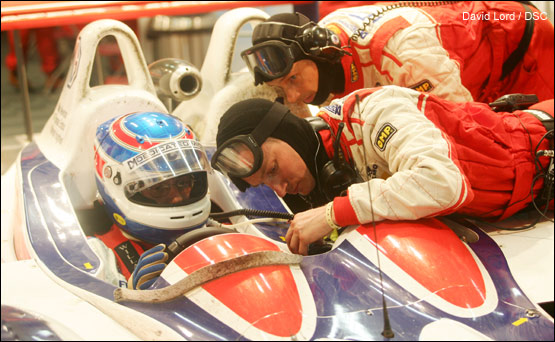
At
ten past eight, Mike Newton was back in the pits,
but this was no scheduled stop. "I was just
coming in to the first chicane when I lost all
indications on the dashboard," explained
Mike. It appeared that the paddle-shift gearchange
system also failed at the same time, so he was
forced to switch to the manual system. "The
gearlever was also jammed, so I freewheeled for
a way. Then I managed to get it working again,
so I could use that to get back to the garage.
We think it may be something as simple as a blown
fuse, but we'll have to investigate," he
said. In every other respect Mike seemed delighted
by his stint in the car. "The car is absolutely
terrific at the moment. There's a little understeer,
but nothing you can't steer through."
It
would end up being a twenty-minute stop, and cost
two of those hard-earned places, so by the time
Warren Hughes took over at half-eight, the RML
MG was lying in 38th position once again. When
Hughes opened his account with a 3:54.203, followed
that with a 3:53.368, and then passed the Spyker
(again!) with a 3:51.082 to reclaim 37th, it was
clear that the former F3 Champion was on a real
charge. So too was Sam Hancock, still leading
the class in the Intersport Lola and setting his
best lap of the race so far; a 3:49.564 being
the first to better Tommy's earlier time. With
the sun sinking in the west, the track was starting
to cool just enough to make conditions a bit quicker
for the cars, and more pleasant for the drivers.
Back to top
Hour
Six
Another
succession of quick laps from the MG culminated
in a blistering 3:49.260 at just after eight o'clock
to reclaim the honour of being the fastest in
class. Almost simultaneously Warren overtook the
#69 Ferrari, and then went quicker still with
a 3:49.221to sail past the #52 Ferrari and into
35th position. Various thoughts of "if only"
were going through the minds of those scanning
the timing screens.
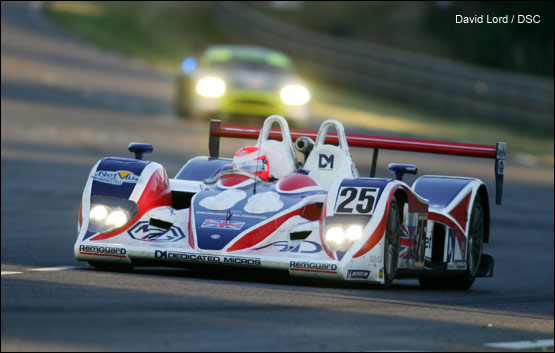
Warren's
laps were proving very consistent, and consistently
quick. Rarely dropping below three fifty two,
he was gaining on the #92 Cirtek GT2 Ferrari by
about 30 or 40 seconds a lap, and with the #51
stopped beside the track since just after nine,
two slots were in the offing, and quite soon.
The first came at twenty to ten, with Warren passing
the stranded #51 to inherit 34th. That left him
a lap behind the #92, but closing rapidly, sometimes
by a minute a lap.
Hour
Seven
Ten-to-ten
and Warren posted another fastest lap of the race
- and the class. His best of 3:48.902 was nearly
seven tenths ahead of anything anyone else had
managed, including Hancock in the class-leading
Lola. Five minutes later and last year's RML co-driver,
Nathan Kinch, ended his 2005 charge by plunging
the Scuderia Ecosse Ferrari 360 nose-first into
a tyrewall. His misfortune was RML's gain, and
just before the hour, Warren swept through unchallenged
into 33rd place.
A
quarter distance in the 73rd running of the Le
Mans 24 Hours and Warren Hughes at the wheel of
the RML MG Lola stood less than a minute behind
his next target, the #92 Cirtek Ferrari. A single
lap later and the margin had narrowed to a mere
fourteen seconds. Before they completed a third
tour Hughes had taken 32nd place, and with it
had made the encouraging move into the second
timing screen.
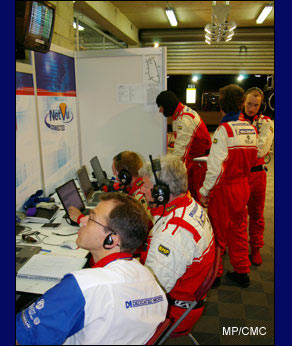 Some
distance ahead of Warren on the track stood Val
Hillebrand in the #35 Courage, but the margin
was coming down only gradually; typically by just
ten seconds a lap. More likely to make a difference
was the fact that both were bearing down on a
gaggle of GT cars, although to put this in perspective,
the Intersport Lola #32, still leading LMP2, enjoyed
a ten-lap advantage over the battle. Even so,
that was starting to look less and less like an
insurmountable mountain, especially as Warren
was currently circulating quicker than almost
everyone ahead of him. Only the leading LMP1 runners
were going quicker. Some
distance ahead of Warren on the track stood Val
Hillebrand in the #35 Courage, but the margin
was coming down only gradually; typically by just
ten seconds a lap. More likely to make a difference
was the fact that both were bearing down on a
gaggle of GT cars, although to put this in perspective,
the Intersport Lola #32, still leading LMP2, enjoyed
a ten-lap advantage over the battle. Even so,
that was starting to look less and less like an
insurmountable mountain, especially as Warren
was currently circulating quicker than almost
everyone ahead of him. Only the leading LMP1 runners
were going quicker.
It
wasn't easy going by any means, and Warren was
battling his way through the traffic. The television
cameras picked him up on the run between Tetre
Rouge and the first Mulsanne Chicane, flashing
his headlights at one of the Astons in an attempt
to clear a path. "It's so difficult passing
those GT1 cars, especially those Astons. You get
into a rhythm, and learn where's best to pass.
Some of the professional drivers are excellent,
especially the Corvettes, but I wonder about the
Astons sometimes.
If he'd breathed off the throttle for a second,
we would have been fine, but he was clearly blocking
me. I'm not sure that's right." The prototypes
are fitted with white headlights, the GT cars
use yellow, so it should be simple enough for
the slower drivers to know when a faster car is
coming through.
Back to top
Hour
Eight
Coming
up to eleven o'clock and there was drama for one
of the smaller teams in this year's race. The
Dutch Spyker had a rough time in the official
test, and then again in qualifying, so it was
no great surprise when it started last. Yet within
the first hour it had made up eleven places, and
was going strong. Now, seven hours into the race,
its charge was at an end. Heading into Indianapolis,
the engine blew bigtime, pitching the car into
a spin and engulfing the rear end in flames. The
safety car was immediately deployed, and one lap
ahead of schedule, Warren Hughes headed swiftly
for the pitlane.
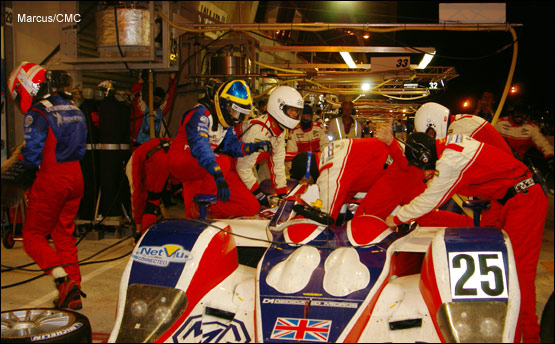
The
team performed a remarkably quick pitstop - completing
the refuelling while Tommy took over Warren's
place in the cockpit. Fresh tyres all round, a
quick rip away of the protective film on the acrylic
headlight covers, and the car was ready to go.
Tommy would take up his position in the 'train'
having lost precious little time at all. It was
an exemplary pitstop.
First
impressions suggested that Warren Hughes was suffering.
"I'm sorry, I can't hear very well, and I've
lost my voice," he said in a croaky whisper.
"I felt rough earlier in the week; all achy,
like it was flu, but I do feel fine now, really"
he insisted reassuringly. It soon became clear
that he was actually far better than he sounded,
and had enjoyed his lengthy stint. "I wasn't
expecting to do a triple!" he grinned. "I
still had a tinted visor on, and my eyes were
on stalks during the last hour, just to see where
I was going, but it seemed to go quite well."
He had not only captured a number of places, he'd
also taken back several laps on some of those
ahead of him. "I was behind Sam Hancock when
I started, but took a lap back from him - it might
even have been two, I think. They're very good
in the corners, but we've got some good top speed.
There's not a lot in it really, in terms of car
performance, but I was in a groove. I was able
to keep up a good pace without taking any crazy
risks." The tyres had also performed well.
"The grip at the rear was just starting to
go towards the very end of my stint," he
said, "but the grip had been excellent throughout
and the car's going like clockwork now. It didn't
look too promising at the start, did it?"
That
was probably an understatement, but this is a
very long race, and as they always say, anything
can happen - and often does. With the race resumed
at 11:17, Tommy was lapping consistently in the
3:55 to 3:57 bracket, on full tanks, and making
up three or four seconds a lap on the #35 Courage.
First victim to fall to both would be the #31
Noel del Bello Courage, which had been stuck in
its garage for the best part of half an hour.
The RML MG had achieved the dizzy heights of 31st
place overall.
Back to top
Hour
Nine
Just
before midnight Tommy came back into the pits
for his first scheduled pitstop of this, his second
stint. The car was refuelled, but the Michelins
were obviously ripe for a second stint, so no
loss of time changing those. Apart from a quick
tinker in the passenger footwell, this was another
routine pitstop, and the MG was soon on its way
once again. Throughout this period Tommy's times
remained very consistent, but as the car lightened,
they gradually became quicker, moving ever closer
to that three-fifty mark.
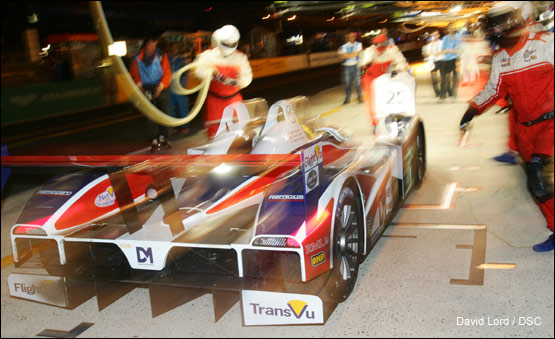
With
Hugh Chamberlain's Synergy-sponsored Lola already
an early retirement, trouble was about to hit
the long-standing class leader, the similar AER-powered
Intersport car. At twenty past twelve the car
began its first lengthy pitstop, with a fluid
leak, and that ten-lap advantage was disappearing
fast. Even after that had been fixed, a serious
vibration set in that heralded more serious problems
in the pipeline. Tommy had already moved onto
the same lap as the #35 G-Force Courage, and both
had passed the #91 T2M Porsche, so the RML car
was now lying 30th overall. In a bizarre twist
to an earlier incident, the #34 Miracle Courage
was then excluded from the race, having freewheeled
backwards down the hill from the Dunlop Chicane
and into the pitlane while the safety car was
circulating. This was deemed, somewhat unsurprisingly,
to have been a foolhardy move.
Back to top
Marcus
Potts |
